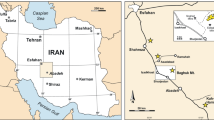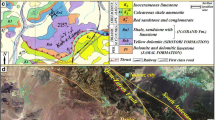Abstract
The microfacies sequence in the key interval of Beds 24–29 of the Meishan section comprehensively recorded the geological events during the Permian-Triassic transition, including the anoxia, storm disturbance, hard-ground/firm-ground form, volcanic eruption, weathering input, and microbialite development. This investigation of event sequences on the microfacies provided synthetically some clues to clarifying the previously proposed mechanisms of the end-Permian extinction. The deposit succession in Bed 24 of the Changxing Formation was developed dominantly with organic-rich lamina, but interrupted intermittently by storm disturbances. It indicates characteristically a stagnated, stratified and anoxic ocean during the latest Permian. The latest Permian transgression occurred rapidly at the top of Bed 24d and was characterized by the hard-ground interface. Abundant clay mineral of illite indicates the occurrence of persistent weathering of continental volcanics and then buried in ocean throughout this key Permo-Triassic transitional interval. However, the “boundary ash clay” of Bed 25 yielding normal grading of hyaloclastite was the result of precipitation of volcanic dusts. The firm-ground substrate in Unit 27-2 was lithe and excavated intensively by trace fossil Glossifungites; it means also the occurrence of the earliest Triassic rapid transgression and coincides with the first appearance of conodont Hindeodus parvus. Dune-shaped microbialite in Unit 27-5 defines biostratigraphically that its development, especially in the carbonate platform of South China, should correspond to the earliest Triassic; and it also indicates the final episode of the end-Permian extinction event.
Similar content being viewed by others
References
Yang Z Y, Wu S B, Yin H F, et al. Permo-Triassic Events of South China (in Chinese). Beijing: Geological Publishing House, 1991
Jin Y G, Wang Y, Wang W, et al. Pattern of marine mass extinction near the Permian-Triassic boundary in South China. Science, 2000, 289: 432–436
Xu D Y, Yan Z. Carbon isotope and iridium event markers near the Permian/Triassic boundary in the Meishan section, Zhejiang Province, China. Palaeogeogr Palaeoclimat Palaeoecol, 1993, 104: 171–176
Becker L, Poreda R J, Hunt A G, et al. Impact event at the Permian-Triassic boundary: Evidence from extraterrestrial noble gases in fullerenes. Science, 2001, 291: 1530–1533
Yin H F, Huang S J, Zhang K X, et al. Volcanism at the Permian-Triassic boundary in South China and its effects on mass extinction (in Chinese). Acta Geol Sin, 1989, 63(2): 169–181
He J W, Rui L, Chai Z F, et al. The latest Permian and earliest Triassic volcanic activities in the Meishan area of Changxing, Zhejiang (in Chinese). J Stratigr, 1987, 11(3): 194–199
Kamo S L, Czamanske G K, Amelin Y, et al. Rapid eruption of Siberian flood-volcanic rocks and evidence for coincidence with the Permian-Triassic boundary and mass extinction at 251 Ma. Earth Planet Sci Lett, 2003, 214(1–2): 75–91
Bowring S A, Schoene B, Crowley J L, et al. High-precision U-Pb zircon geochronology: Progress and potential. Geochim Cosmochim Acta, 2007, 71(15): A117
Xie S C, Pancost R D, Yin H F, et al. Two episodes of microbial change coupled with Permo/Triassic faunal mass extinction. Nature, 2005, 434(7032): 494–497
Yin H F, Feng Q L, Baud A, et al. The protracted Permo-Triassic crisis and multi-episode extinction around the Permian-Triassic boundary. Glob Planet Change, 2007, 55(1–3): 1–20
Wang C J. Anomalous hopane distributions at the Permian-Triassic boundary, Meishan, China: Evidence for the end-Permian marine ecosystem collapses. Org Geochem, 2007, 38: 52–66
Berner R A. The carbon and sulfur cycles and atmospheric oxygen from middle Permian to middle Triassic. Geochim Cosmochim Acta, 2005, 69: 3211–3217
Kiehl J T, Shields C A. Climate simulation of the latest Permian: Implications for mass extinction. Geology, 2005, 33(9): 757–760
Grice K, Cao C Q, Love G D, et al. Photic zone euxinia during the Permian-Triassic superanoxic event. Science, 2005, 307(5710): 706–709
Erwin D H, Bowring S A, Jin Y G. End-Permian mass extinctions: A review. Spe Paper Geol Soc Am, 2002, 356: 363–383
Yin H F, Wu S B, Ding M H, et al. The Meishan section, candidate of the globle stratotype section and point of Permian-Triassic boundary. In: Yin H F, ed. The Palaeozoic-Mesozoic Boundary, Candidate of the Globle Stratotype Section and Point of Permian-Triassic Boundary. Wuhan: China University of Geosciences Press, 1996. 31–48
Zhang K X, Tong J N, Shi G R, et al. Early Triassic conodont-palynological biostratigraphy of the Meishan D Section in Changxing, Zhejiang Province, South China. Palaeogeogr Palaeoclim Palaeoecol, 2007, 252(1–2): 4–23
Cao C Q, Shang Q H. Microstratigraphy of Permo-Triassic transitional sequence of the Meishan section, Zhejiang, China. Palaeoworld, 1998, 9: 147–152
Kaiho K, Chen Z Q, Kawahata H, et al. Close-up of the end-Permian mass extinction horizon recorded in the Meishan section, South China: Sedimentary, elemental, and biotic characterization and a negative shift of sulfate sulfur isotope ratio. Palaeogeogr Palaeoclimot Palaeoecol, 2006, 239(3–4): 396–405
Twitchett R J, Looy C V, Morante R, et al. Rapid and synchronous collapse of marine and terrestrial ecosystems during the end-Permian biotic crisis. Geology, 2001, 29(4): 351–354
He J W, Clay minerals in the Changhsingian stratotype section and the basal part of Yinkang Formation, with reference to the Permo-Triassic boundary (in Chinese). J Stratigr, 1981, 5(3): 197–206
Huang X Y, Jiao D, Lu L Q, et al. Distribution and geochemical implication of aromatic hydrocarbons across the Meishan Permian-Triassic boundary (in Chinese). J China Univ Geosci, 2006, 17(1): 49–54
Wang C J, Liu Y M, Liu H X, et al. Geochemical significance of the relative enrichment of pristine and the negative excursion of δ 13 C pr across the Permian-Triassic boundary at Meishan, China (in Chinese). Chin Sci Bull, 2005, 50(21): 2380–2391
Chai Z F, Zhou Y Q, Mao X Y, et al. Geochemical constraints on the Permo-Triassic boundary event in South China. In: Sweet W C, Yang Z Y, Dickins J M, et al, eds. Permo-Triassic Events in the Eastern Tethys: Stratigraphy, Classification, and Relations with the Western Tethys. Cambridge: Cambridge University Press, 1992. 158–168
Huang S J, Qing H, Huang P P, et al. Evolution of strontium isotopic composition of sea-water from Late Permian to Early Triassic based on study of marine carbonates, Zhongliang Mountain, Chongqing, China. Sci China Ser D-Earth Sci, 2008, 51(4): 528–539
Wang C J, Visscher H. Abundance anomalies of aromatic biomarkers in the Permian-Triassic boundary section at Meishan, China-Evidence of end-Permian terrestrial ecosystem collapse. Palaeogeogr Palaeoclim Palaeoecol, 2007, 252: 291–303
Sephton M A, Looy C V, Brinkhuis H, et al. Catastrophic soil erosion during the end-Permian biotic crisis. Geology, 2005, 33(12): 941–944
Rees P M. Land-plant diversity and the end-Permian mass extinction. Geology, 2002, 30: 827–830
Kerp H A, Hamad A, Vörding B, et al. Typical Triassic Gondwanan floral elements in the Upper Permian of the paleotropics. Geology, 2006, 34(4): 265–268
Knoll A H, Bambach R K, Payne J L, et al. Paleophysiology and end-Permian mass extinction. Earth Planet Sci Lett, 2007, 256(3–4): 295–313
Wu Y S, Jiang H X, Yang W, et al. Microbialite of anoxic condition from Permian-Triassic transition in Guizhou, China. Sci China Ser D-Earth Sci, 2007, 50(7): 1040–1051
Kershaw S, Li Y, Sylvie C S. Earliest Triassic microbialites in the South China block and other areas: Controls on their growth and distribution. Facies, 2007, 53: 409–425
Fang S X, Hou F H, Dong Z X. Non-stromatolite ecologic system Cyanobacteria dolostone in Dengying Formation of Upper Sinian (in Chinese). Acta Sendiment Sin, 2003, 21(1): 96–105
Zhang K X, Tong J N, Yin H F, et al. Sequence stratigraphy of Permian-Triassic boundary of Changxing, Zhejiang (in Chinese). Acta Geol Sin, 1996, 70(3): 270–281
Zhang K X. The Permo-Triassic conodont fauna in Changxing area, Zhejiang Province and its stratigraphic significance (in Chinese). Earth Sci J-China Univ Geosci, 1987, 12(2): 193–200
Author information
Authors and Affiliations
Corresponding author
Additional information
Supported by Chinese Academy of Sciences (Grant No. KZCX2-YW-122), Project of the Ministry of Science and Technology of China (Grant No. 2006CB806400) and National Natural Science Foundation of China (Grant No. 40473003)
Rights and permissions
About this article
Cite this article
Cao, C., Zheng, Q. Geological event sequences of the Permian-Triassic transition recorded in the microfacies in Meishan section. Sci. China Ser. D-Earth Sci. 52, 1529–1536 (2009). https://doi.org/10.1007/s11430-009-0113-0
Received:
Accepted:
Published:
Issue Date:
DOI: https://doi.org/10.1007/s11430-009-0113-0




